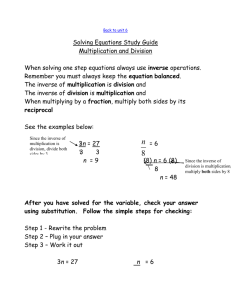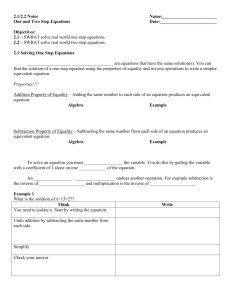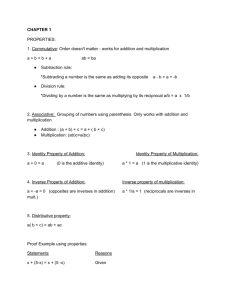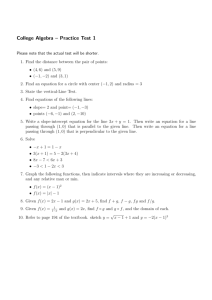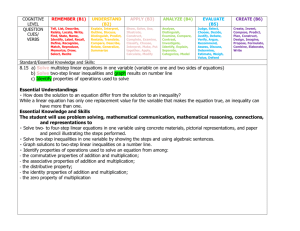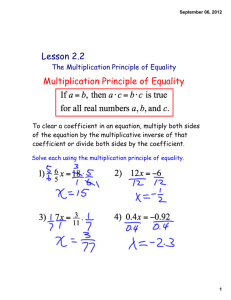a a ∙ = = ∙ 1 1 a a a ∙ = = ∙ 1 1 1
advertisement
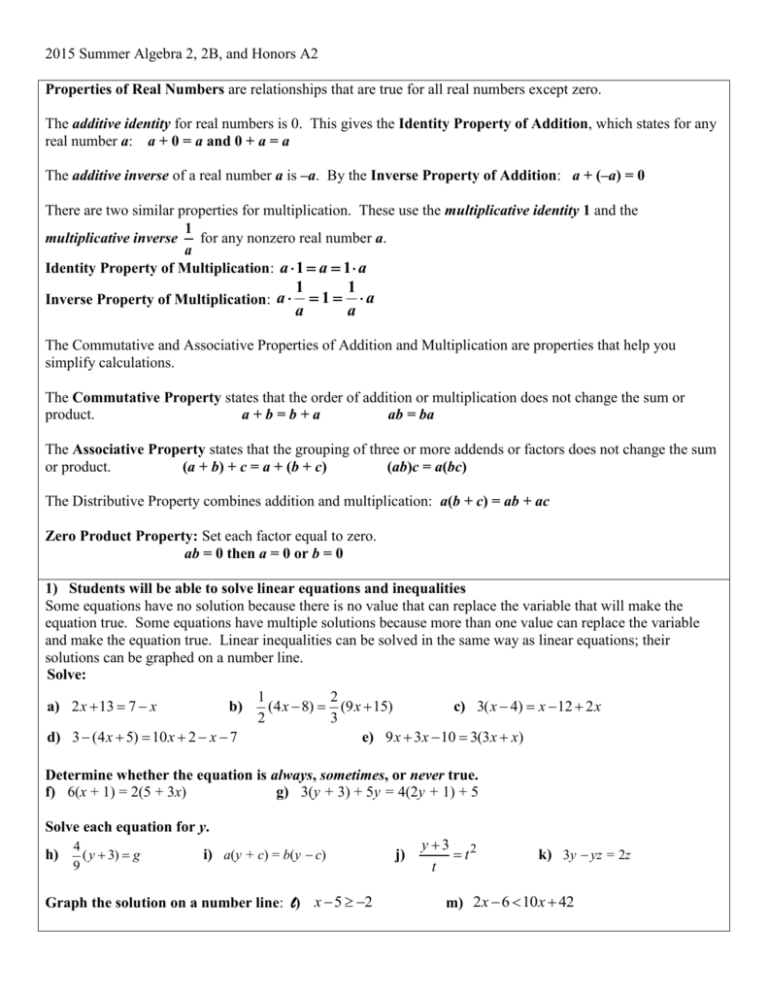
2015 Summer Algebra 2, 2B, and Honors A2 Properties of Real Numbers are relationships that are true for all real numbers except zero. The additive identity for real numbers is 0. This gives the Identity Property of Addition, which states for any real number a: a + 0 = a and 0 + a = a The additive inverse of a real number a is –a. By the Inverse Property of Addition: a + (–a) = 0 There are two similar properties for multiplication. These use the multiplicative identity 1 and the 1 multiplicative inverse for any nonzero real number a. a Identity Property of Multiplication: a 1 a 1 a Inverse Property of Multiplication: a 1 1 1 a a a The Commutative and Associative Properties of Addition and Multiplication are properties that help you simplify calculations. The Commutative Property states that the order of addition or multiplication does not change the sum or product. a+b=b+a ab = ba The Associative Property states that the grouping of three or more addends or factors does not change the sum or product. (a + b) + c = a + (b + c) (ab)c = a(bc) The Distributive Property combines addition and multiplication: a(b + c) = ab + ac Zero Product Property: Set each factor equal to zero. ab = 0 then a = 0 or b = 0 1) Students will be able to solve linear equations and inequalities Some equations have no solution because there is no value that can replace the variable that will make the equation true. Some equations have multiple solutions because more than one value can replace the variable and make the equation true. Linear inequalities can be solved in the same way as linear equations; their solutions can be graphed on a number line. Solve: 1 2 a) 2 x 13 7 x b) (4 x 8) (9 x 15) c) 3( x 4) x 12 2 x 2 3 d) 3 (4 x 5) 10 x 2 x 7 e) 9 x 3x 10 3(3x x) Determine whether the equation is always, sometimes, or never true. f) 6(x + 1) = 2(5 + 3x) g) 3(y + 3) + 5y = 4(2y + 1) + 5 Solve each equation for y. h) 4 ( y 3) g 9 i) a(y + c) = b(y c) Graph the solution on a number line: l) x 5 2 j) y 3 2 t t k) 3y yz = 2z m) 2 x 6 10 x 42 2015 Summer Algebra 2, 2B, and Honors A2 2) Determine whether each relation is a function. 3) Use Proportions to solve. a) If y = 3 when x = 9, find x when y = 5. b) If y = 14 when x = 7, find x when y = 22. c) If y = 5 when x = 8, find x when y = 2. d) If y = 4 when x = 14, find y when x = 5. e) The distance a spring stretches varies directly with the amount of weight that is hanging on it. A weight of 2.5 pounds stretches a spring 18 inches. What is the stretch of the spring when a weight of 6.4 pounds is hanging on it? f) The amount of lemon juice in a lemonade recipe varies directly with the amount of water. The recipe calls for 8 oz of lemon juice and 32 oz of water. How much lemon juice should you use if you start with 28 oz of water? 4) Students will be able to graph points and lines on a coordinate plane Points can be identified by ordered pairs, written (x, y). The x-coordinate is positive in Quadrants I and IV; the y y y-coordinate is positive in Quadrants I and II. The slope of a line can be calculated as m 2 1 x2 x1 Find the slope of the line through each pair of points. a) (0, 1) and (3, 0) b) (3, 2) and (1, 6) c) (4, 1) and (2, 3) Write an equation for each line in slope-intercept form. d) m = 4 and the y-intercept is 3. e) m 2 17 and the y-intercept is . 5 5 Find the equation of each line in slope-intercept form. f) g) h) 2015 Summer Algebra 2, 2B, and Honors A2 5) Standard form of a linear equation Ax + By = C; A, B, C are integers and A > 0. Write an equation of each line in standard form with integer coefficients. 3 1 3 1 a) y x b) y x c) y = 4.2x + 1.8 2 4 2 2 4 5 d) y x 5 6) Parallel lines have equal slopes and do not intersect. Perpendicular lines have opposite reciprocal slopes and intersect at a right angle. Write the equation of the line through each point. Use slope-intercept form. a) through (7, 1) and perpendicular to y = x + 3 b) through (2, 9) and parallel to y = 3x 2 c) through (3, 1) and perpendicular to 4x + y 1 = 0 d) through (–6, 2) and perpendicular to x = 2 7) Linear inequalities can be graphed by graphing the boundary line, and then shading above or below the boundary to include all points that make the inequality true. Graph each inequality on a coordinate plane. a) 4x + 2y 8 1 6 b) 3x 5y c) y x 1 8) Students will be able to simplify expressions using Integer Exponent Rules: n 1 am an am n a m a mn a n n a am a n amn 1 ( ab) m a mb n a m m a a n b b Simplify with positive exponent answers. a) a b a 2b2 a 2b b) an a0 1 a2b3 0 a5b7 2 3 3 5 n c) a 2b7 d) a 0b9 a2b3 2 ANSWERS: 1a) x 2 g) always l) x 3 b) x 7 h) y 2 9 g 3 4 c) all reals ac bc ba m) x 6 i) y d) x 3 13 e) j) y t 3 3 f) never k) y 2z 3 z 2015 Summer Algebra 2, 2B, and Honors A2 2a) Yes b) No 3a) 15 b) 11 1 0 1 0 3 3 2 17 e) y x 5 5 4a) c) Yes 16 5 c) b) 2 1 3 1 3 6 9 3 f) y 4 x 2 5a) 3x 2 y 1 1 2 1 43 7 1 x 1 2 d) y 4 x 3 d) 4 x 5 y 25 d) y 2 7b) 7c) y x x a5 b 7 y f) 7 ounces h) y 2 x 2 1 7 x 4 4 c) y y 8a) e) 46.08 inches c) 42 x 10 y 18 b) y 3x 3 7a) c) g) y b) 6 x 4 y 1 6a) y x 6 10 7 d) b) a8 b 4 c) a4 b 6 x d) a 4b3


